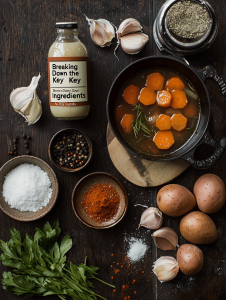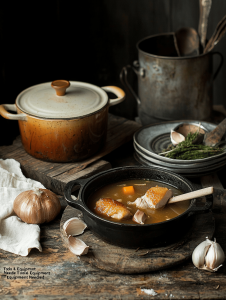Chicken soup often feels like a warm hug, but I like to think of this version as a slow dance. It’s not about quick fixes or shortcuts, but about allowing the flavors to develop in their own time. The result is a bowl that tastes like something you’ve been simmering over days, even if it’s only a couple of hours.
Why I Keep Coming Back to This Soup
It’s a reminder that slow cooking yields the best flavor. The process is calming, and the final bowl offers a complex, comforting taste that can’t be rushed. Plus, it’s endlessly adaptable, making each batch a little different and special.
Breaking Down the Key Ingredients
- Chicken thighs: Rich in flavor and fat, they become super tender after braising. You can swap with drumsticks or even a whole chicken for more flavor.
- Onions, carrots, celery: The classic soffritto base. Adds sweetness, depth, and aroma. Feel free to toss in parsnips or leeks for a twist.
- Lemon juice: Brightens the broth with a citrus zing, balancing the richness. Lime works in a pinch for a different vibe.
- Homemade chicken broth: The backbone of flavor. Use store-bought but opt for low sodium and add your own herbs.
- Salt & pepper: Essential for seasoning, but taste as you go to avoid over-salting.
- Fresh herbs (parsley, thyme): Add at the end for fresh, herbal brightness.
- Crusty bread: A crunchy side that complements the soup’s softness.
Tools & Equipment Needed
- Heavy-bottomed pot: Prevents hot spots and ensures even cooking.
- Sharp knife: For chopping vegetables and shredding chicken.
- Wooden spoon or spatula: Stirring and scraping the bottom to prevent sticking.
- Ladle: Serving the broth and solids neatly.
Step-by-Step for a Slow-Braised Chicken Soup
Step 1: Start with a heavy-bottomed pot, heat a splash of oil over medium heat.
Step 2: Sauté chopped onions, carrots, and celery until they soften and smell sweet, about 8 minutes.
Step 3: Add chicken pieces—thighs work best—brown them well, about 10 minutes, until skin is golden.
Step 4: Pour in enough water or homemade chicken broth to cover the meat and simmer gently.
Step 5: Skim any foam that rises to the top for a cleaner broth.
Step 6: Reduce heat to low, cover, and let everything braise for at least 2 hours, until the chicken is fall-apart tender.
Step 7: Remove the chicken, shred it, then return it to the pot. Season with salt, pepper, and a squeeze of lemon for brightness.
Step 8: Let the soup rest off heat for 10 minutes, then serve hot with crusty bread.
Cooking Checkpoints & Tips
- The broth should be rich and slightly cloudy, with a deep chicken aroma.
- Chicken meat easily pulls apart when tested with a fork, indicating perfect tenderness.
- Vegetables should be soft but not mushy, adding texture without losing shape.
Common Mistakes & How to Fix Them
- Cooking with too high heat, causing rapid evaporation.? Add more water or broth if the soup reduces too much and thickens too quickly.
- Not skimming foam, resulting in a cloudy broth.? Skim foam regularly to keep the broth clear.
- Seasoning too early or too late.? Adjust seasoning before serving, especially salt and lemon.
- Removing chicken too early.? If chicken isn’t shredding, give it more time or check if it’s truly cooked through.

Slow Braised Chicken Soup
Ingredients
Equipment
Method
- Heat a heavy-bottomed pot over medium heat and add a splash of olive oil. Once shimmering, add chopped onions, carrots, and celery. Cook, stirring occasionally, until the vegetables soften and release a sweet aroma, about 8 minutes.

- Add the chicken thighs to the pot and cook until they develop a golden-brown crust, about 10 minutes. Use a wooden spoon to turn the chicken, ensuring even browning and releasing flavorful browned bits from the bottom.

- Pour in the chicken broth, enough to cover the chicken and vegetables. Bring the mixture to a gentle simmer, and skim off any foam that rises to the surface to keep the broth clear and clean-tasting.

- Add thyme sprigs to the pot, cover loosely, and reduce the heat to low. Let everything braise slowly for at least 2 hours, until the chicken is falling apart and the flavors meld beautifully.

- Once cooked, remove the chicken thighs from the pot and shred the meat with two forks. Discard the thyme sprigs. Return the shredded chicken to the soup and stir to combine.

- Stir in fresh lemon juice, then taste and season with salt and pepper as needed. The lemon brightens the deep flavors and adds a fresh zing to the broth.

- Let the soup rest off the heat for about 10 minutes to allow flavors to meld further. Then, ladle into bowls, garnish with chopped parsley, and serve hot with crusty bread on the side.
Leave a Reply